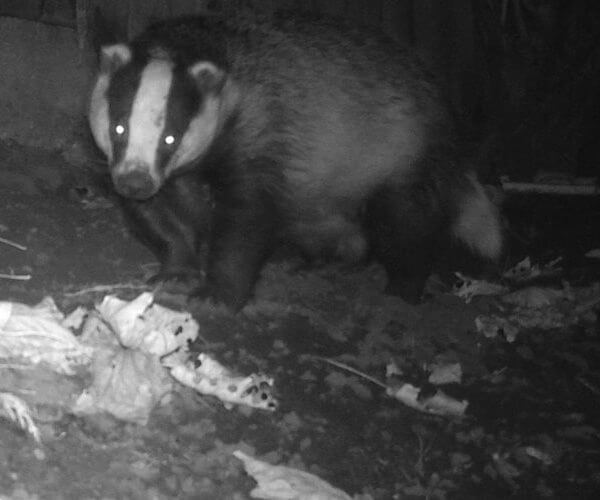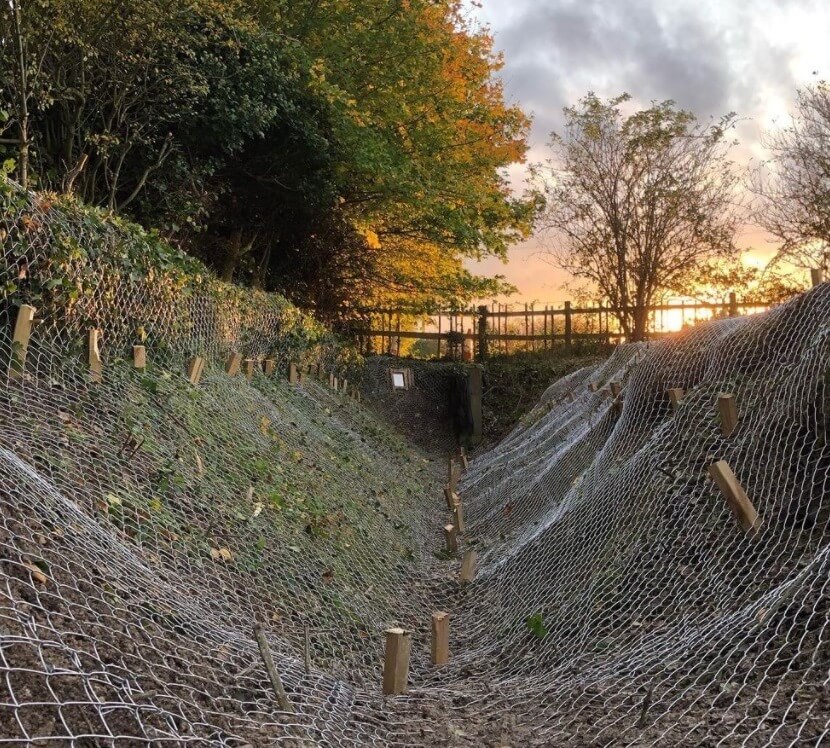

Our ecologists at Morph Ecological Consultants are extremely experienced in undertaking badger surveys as well as designing and implementing mitigation measures when badger setts may be impacted by development projects. We have undertaken badger surveys predominantly across Nottinghamshire, Derbyshire and Leicestershire, but have also worked on numerous badger mitigation projects across England.
Please see our ‘Frequently Asked Questions: Badgers’ page for more information on badger surveys, licences to allow works that might impact badger setts, and other information regarding badgers.
Badger surveys typically involve our ecologists undertaking an initial walk-over survey of a site, to search for evidence of badgers. Badger setts, latrines, badger hairs caught on wire, well-worn paths typical of badgers and snuffle holes (evidence of feeding) are all noted during these surveys. Badger surveys can be carried out throughout the year but optimum survey timing is autumn to early spring when vegetation cover is reduced, making the identification of setts within dense habitat easier.
At Morph Ecological Consultants, we also use motion triggered trail cameras as part of our badger survey work to identify the level of badger activity and to give an indication on the number of badgers using the sett. We also use motion triggered trail cameras during artificial sett creation (when enticing badgers to use their new setts) and during sett exclusion works (to determine when badgers have vacated the sett). The use of cameras gives definitive evidence that badgers are or are not using a sett. We have found the use of such cameras as part of our badger surveys invaluable over the years and has the potential to save time and money for our clients further down the line.

Badgers and their setts are protected by law. A badger sett is defined by law as ‘any structure or place which displays signs indicating current use by a badger’.
Under the Protection of Badgers Act 1992 it is an offence to:
It is therefore important to consult with an ecologist to determine if your proposals may impact upon a badger sett to prevent a criminal offence. In the first instance, our ecologists would assist with the possibility of redesigning the proposals to avoid impacts to a badger sett. If this is not possible, then a badger sett closure may become necessary.
Badger sett closure works can only be undertaken under a licence from Natural England and can only be carried out between July and November (inclusive). This avoids the times when dependant badger cubs are below ground. Typically, Natural England require 30 working days following submission of the application forms to determine a licence request. However, our team includes an ecologist with a Badger Class Licence, which reduces the time taken to determine an application to just 5 working days.
Sett closure works involve the use of robust one-way gates (essentially strong cat-flaps) installed at each badger sett entrance. To prevent the badgers digging around the sides of the gates, strong wire mesh is also installed. Badgers are extremely strong animals, and as such great care is required when our team install the gates and mesh to ensure the badgers cannot re-enter the sett. To ensure all badgers have vacated the sett prior to works commencing, a monitoring period of 21 days is carried out, with frequent visits to the sett to assess when the badgers have vacated.
Ideally developments can be designed to avoid permanently impacting a badger sett, or a badger clan’s foraging habitat. It is possible to temporarily close a sett, or temporarily disturb areas of the sett. However, on occasions it is not possible to avoid impacts therefore mitigation and compensation measures become necessary if an important sett is to be permanently closed. Our team have designed and built numerous successful artificial setts across the country, ranging from small artificial setts to replace outlier setts, to large complex artificial setts to replace very active main badger setts. The construction of an artificial sett can also be valuable to try and entice badgers further away from areas they could potentially disturb (e.g. around buildings).
Our artificial badger setts aim to mimic natural badger setts as closely as possible and comprise of interconnecting tunnels and chambers to recreate the conditions typically found. Our ecologists undertake detailed survey work to ensure that the artificial badger setts are positioned in locations suitable for use by badgers. This includes ensuring that the proposed artificial sett location is within the badger clan’s territory, but does not impact on neighbouring territories, and that ground conditions are suitable for construction of the new sett.
When a project requires the construction of an artificial badger sett, a period of enticing the badgers to the new artificial sett is carried out (via the use of peanuts, which are placed at discrete locations close to the new artificial sett), to help ensure a successful move.
Each project is extremely unique as no two badger setts are ever the same, so it’s always recommended to get in contact with an ecologist early in the process to avoid any potential delays.
Badger bait marking surveys are sometimes used to identify the extent of a badger clan’s territory. The survey involves mixing edible, coloured pellets with peanuts and syrup, which are then placed around the sett(s) being surveyed. The badgers readily eat the peanut mixture and then a few days later our ecologists undertake latrine surveys in search of the coloured pellets. From the location of the different colour pellets, it is possible to map the extent of the badger clan’s territory. Badger bait marking surveys are very useful when determining if a project might impact the foraging area of a badger clan and are also useful when determining the location to build artificial setts.
Although our badger work is primarily driven by development projects, our team are committed to badger conservation and protection. Our team have worked with local conservation charities on their badger vaccination projects (one of our directors is a ley vaccinator) to help prevent bovine TB infecting local badger populations and thereby protecting local dairy herds.
Nottinghamshire Wildlife Trust's Badger Vaccination Scheme

Morph Ecological Consultants carried out a badger sett closure under licence, in order to re-excavate a section of a former canal, which is being restored.
An initial walk over survey was carried out in late September, with a period of monitoring carried out after. A subsidiary sett, outlier sett and a main sett was recorded during the survey. Only the subsidiary canal sett was located with the area of works, and impacts could not be avoided due to being located within the area of canal to be re-excavated. The monitoring period revealed that the subsidiary sett was partially active with a small number of badgers. As the main sett was not going to be impacted by the works, it was not considered necessary to construct an artificial sett.
Sett closure works can only occur between the 1st July and 30th of November, therefore a regular licence to Natural England wouldn’t have been possible that year. Fortunately, one of our ecologists has a badger Class Licence, which fast tracks the Licence determination from Natural England from 30 working days to 5 working days.
We worked with the volunteers from the restoration project to install the one-way gates and the mesh. This made the process quicker and cheaper for the client, whilst also providing the volunteers an opportunity to learn more about badger ecology.
The badgers left the sett during the 21 day monitoring period, and the works were able to commence during the middle of November without harming any badgers. The badger tunnels were excavated under supervision of one of our ecologists. During the excavation works it was discovered that the badger tunnels extended well over 2m deep and were much more extensive than previously thought.
The client was able to proceed with the canal restoration without having any delays on the project. Advise was also provided to prevent impacts to badgers further along in the scheme and prevent a possible breach of legislation with the future works.

"Right from the get go, Steve and Nikki were very responsive and quick to come on site to perform a survey. They clearly explained the costs involved and the work that needed to be done, they performed all the work to a very high standard. They were also very knowledgeable and were able to provide their recommendations to lower the impact to wildlife else where on the site."
William - Canal Restoration Group